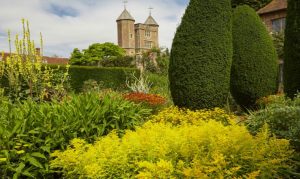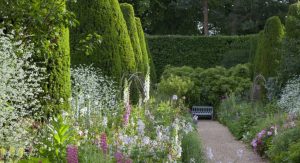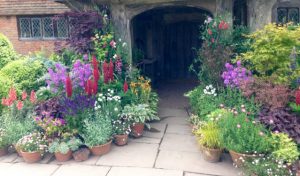Event date: Monday 21st March 2016
Speaker: Martin Walker
Write-up by Ian Millichamp
Martin Walker is highly qualified to appraise gardens – he was once head gardener at York Gate garden and is a three-times Chelsea gold medallist. He also proved to be a very accomplished and effective speaker who demonstrates a great love of plants, gardening and gardens.

© The National Trust
He took us on a tour of three of England’s best gardens: it felt like a guided coach tour of a gardener’s dreams. Our first stop was Sissinghurst (www.nationaltrust.org.uk/sissinghurst-castle-garden) in Kent. Although it is rightly famed for its white garden, also impressive is the hard landscaping: especially the red brick archways, walls with roses scrambling over them and buildings, as well as the clipped yew edging which divides the garden into rooms. Martin believes that structure is more important than the plants in any garden.
The Elizabethan tower is an impressive structure and he recommended to go to the top of it first, from where the beautiful view of the whole of the garden layout is visible from above. Especially of note are the Rose Garden, the Cottage Garden, the Orchard (where one can go for a meditative restful break from the higher impact areas) and the South Cottage Garden. The Long Border is full of azaleas and is designed to give a peak of showiness in spring.
Some of the stars of the White Garden are Rosa mulliganii, Gladiolus murielae, Ammi majus and (improbably) Phlox paniculata ‘Rembrandt’. Silver is also prominent in this area e.g. Salvia argentea and Melianthus major.

© The National Trust
Next on our imaginary trip we disembarked at Hidcote (www.nationaltrust.org.uk/hidcote) in Gloucestershire. It was created by an American plant hunter, Lawrence Johnston. One of Martin’s favourite areas is the Old Garden, a cottage style area with Sedum (Hylotelephium) ‘Matrona’, Salvia oxyphora, Echinacea purpurea ‘Vintage Wine’, Helenium ‘Sahin’s Early Flowerer’, and many others. Other highlights are the Pillar Garden (characterised by clipped topiary pillars) and the Pictorial Meadow where annuals are used, their advantage over a conventional meadow is that there is no problem if the soil fertility is high. The Plant House is interesting – a greenhouse with side walls that can be completely removed in the summer where exotics such as Tibouchina urvilleana can be found. In the Fuchsia Garden some unusual and puzzling sculptures are to be seen which resemble comedy breasts – yes this is true!

© greatdixter.co.uk
On our final stop we arrive at Great Dixter (www.greatdixter.co.uk) in East Sussex, Martin’s favourite garden in the UK. It was largely influenced by the late Christopher Lloyd and its care has been ably continued under Fergus Garrett (who himself also recently came and gave a great talk to our group – see Tony Ewin’s write-up in the January newsletter). Some of the many highlights here are the Sunken Garden, the Walled Garden, the Topiary Lawn, the Meadow, the Long Border and the Exotic Garden. Great Dixter and Christopher Lloyd are especially renowned for mixed planting and experimentation with vibrant and contrasting colour and form. Martin went through many of the great plants that can be seen, too many to list here (no phloxes were mentioned), but some of my favourites were Anemone tomentosa, Clerodendrum bungei, Dahlia ‘Chimborazo’, Crocosmia ‘Star of the East’, Helichrysum bracteatum, Canna ‘General Eisenhower’, Lupinus ‘The Page’ with its red spikes and of course Euphorbia griffithii ‘Dixter’.
One of the great aspects of Dixter, apart from the plants, is the fascinating architecture and paving where contrasts of material are again significant. Also the temporary experimental arrangements of plants in pots are fascinating to study. The use of visually unobtrusive, low wooden open hurdles placed at the edges of borders was an interesting means that they use to stop plants flopping onto pathways.
Martin gave us an excellent and informative talk and was full of useful advice. For example he recommends using silver coloured plants to place between other plant combinations which would otherwise clash in colour. The silver diffuses the clash and makes the arrangement look appealing. Also, for exterior boundaries of your garden he has observed that it is better to place a door into the boundary. This gives an illusion that the garden is bigger than it actually is!
It is interesting that the head gardener at all three gardens is male, but I shall draw no conclusions about that, in peril of receiving a lynching at our next meeting.
Editor’s Note: Troy Scott Smith is the first male head gardener in Sissinghurst’s history…
